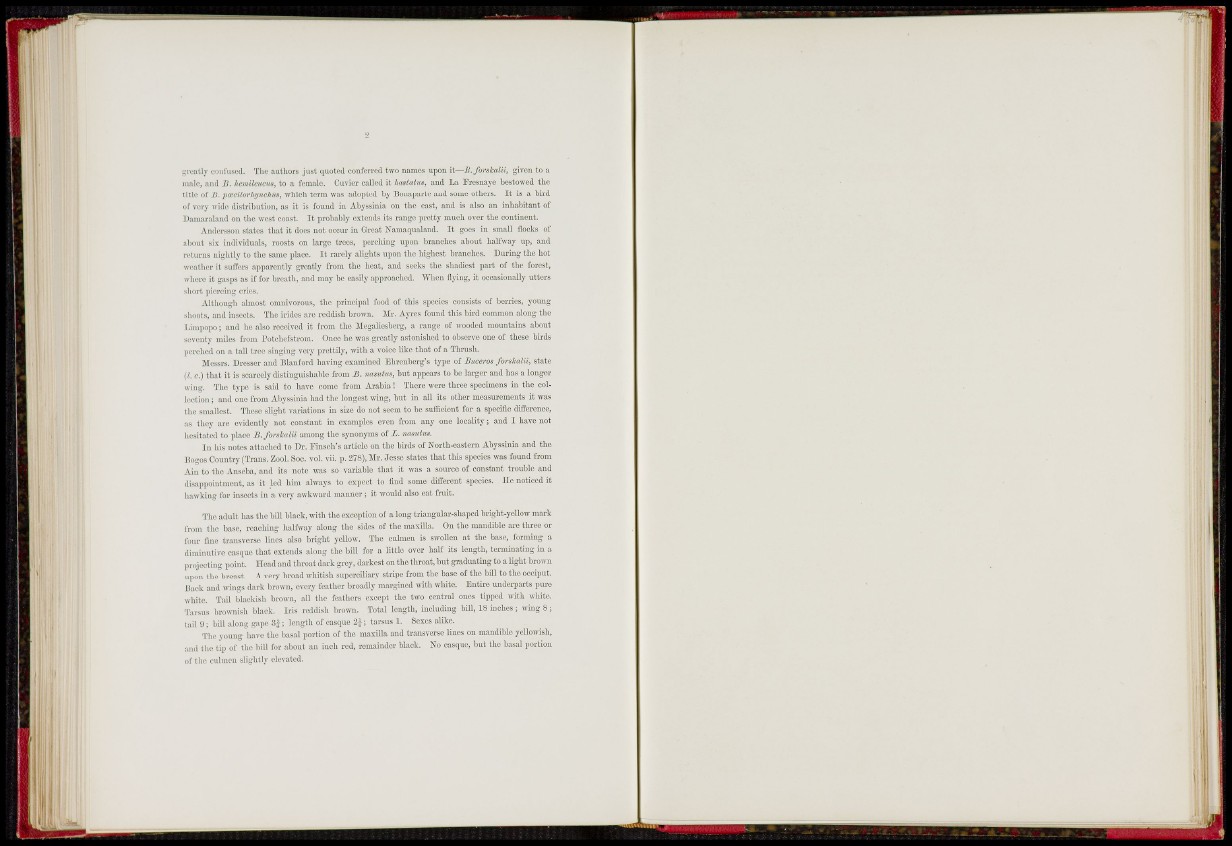
i,n'catly con fused. Tlie authors just quoted conferred two names upon it—B.forskalu, given to a
miilo, and J3. heniileucus, to a female. Cuvicr called it hastatiis, and La Presnayc bestowed the
title of B. pcecitorhynchiis, which term was adopted by Bonaparte and some others. It is a bird
of very wide; distribution, as it is found in Abyssinia on the east, and is also an inhabitant of
Damaraland on the west coast. It probably extends its range pretty mueh over the continent.
Andersson states that it docs not occur in Great Kamaqualand. It goes in small flocks of
about six individuals, roosts on large trees, perching upon branches about halfway up, and
returns nightly to the same place. It rarely alights upon the highest branches. During the hot
weatber it suffers apparently greatly from the heat, and seeks the shadiest part of the forest,
whore it gasps as if for breath, and may be easily approached. When flying, it occasionally utters
short i)iercing cries.
Altliougli almost omnivorous, the principal food of this species consists of berries, young
shoots, and insects. Tlie irides are reddish brown. Mr. Ayrcs found tliis bird common along the
Limpopo; and he also received it from the ilegaliesberg, a range of wooded mountains about
seventy miles from rotcbefstroin. Once he was greatly astonished to observe one of these birds
perched on a tall tree singing very prettily, with a voice like that of a Thrush.
Messrs. Dresser and Blanford having examined Ehvenberg's type of Buceros forskalii, state
{I. c.) that it is scarcely distinguishable from B. nasutiis, but appears to be lai-ger and has a longer
wing. The type is said to have come from Arabia! There were three specimens in the collection
; and one from Abyssinia had the longest wing, but in all its other measurements it was
the smallest. These slight variations in siae do not seem to be sufficient for a specific difference,
as they are evidently not constant in examples even from any one locality; and I have not
lu^itatod to place B. forskalii among the synonyms of X. nasutus.
In his notes attached to Dr. Pinsch's article on the birds of North-eastern Abyssinia and the
Bogos Country (Trans. Zool. Soc. vol. vii. p. 278), Mr. Jesse states that this species was found from
j\.iu to the Anseba, and its note was so variable that it was a source of constant trouble and
disappointment, as it led hira always to expcct to lind some different species. Ue noticed it
hawking for inscets in a very awkward manner ; it would also eat fruit.
The adult has the bill black, with the exception of a long triangular-shaped bright-yellow mark
from the base, reaching lialfwtiy along the sides of the maxilla. On the mandible are three or
four fine transverse linos also bright yellow. Tlie culmen is swoUen at the base, forming a
diminutive casque that extends along the bill for a little over half its length, terminating in a
projecting point. Head and throat dark grey, darkest on the tliroat, but graduating to a light brow n
upon the breast. A very broad whitish superciliary stripe from the base of the bill to the occiput,
iiaek and wings dark brown, every feather broadly margined with white. Entire undcrparts pure
Avhitc. Tail blackish brown, all the feathers except the two central ones tipped with white.
Tarsus brownish black. Iris reddish brown. Total length, including bill, 18 iuehes; wing 8;
l a i l i ) ; bill along giJpc 3 | ; length of casque 2-J-; tarsus 1, Sexes alike.
Tlic young have the basal portion of the maxilla and traaisverse lines on mandible yellowish,
and tbe tip of the bill for about an inch red, remainder black. No casquc, but the basal portion
of the culmen slightly elevated.
wmsm